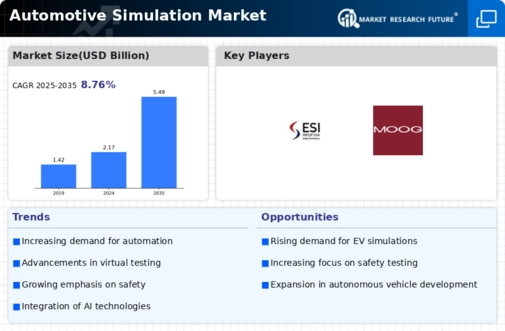Top Industry Leaders in the Automotive Simulation Market
 *Disclaimer: List of key companies in no particular order
*Disclaimer: List of key companies in no particular order
Key Players - Accelerating Their Strategies:
Prominent players propelling the automotive simulation market forward include-
ESI Group (Germany)
dSPACE GmbH (Germany)
ANSYS, Inc. (US)
MOOG INC. (US)
Dassault Systèmes (France)
PG Automotive GmbH (Germany)
TESIS GmbH (Germany)
Siemens PLM (US), and others.
-
Established Titans: Dassault Systèmes, Siemens, PTC, Ansys, and dSPACE assert their dominance, wielding comprehensive software suites and fortified industry relationships. Dassault Systèmes, with its 3DEXPERIENCE platform, caters to diverse simulation needs, while Siemens employs its Xcelerator portfolio for integrated solutions spanning design, test, and optimization.
-
Emerging Challengers: Cognata, Altair, Autodesk, and ESI Group are injecting innovation into the sector. Cognata specializes in autonomous driving simulation, Altair focuses on multi-disciplinary optimization technologies, Autodesk targets mid-tier players with affordable tools, and ESI Group brings a unique focus on virtual prototyping and material testing.
-
Strategic Maneuvers: Acquisitions and partnerships are pivotal in this competitive arena. Siemens' acquisitions of LMS Imagine and CD-adapco, along with PTC's purchase of OnShape, exemplify this trend. Collaborations are flourishing as well, with Siemens and Ansys joining forces for digital twins and Dassault Systèmes partnering with Microsoft Azure for cloud-based solutions.
Factors Influencing Market Share Analysis:
Several factors come into play when dissecting the market share dynamics in the automotive simulation arena:
-
Solution Portfolio Breadth: Players offering comprehensive solutions spanning crash, powertrain, and performance simulations have a competitive edge. Nonetheless, niche players excelling in areas like autonomous driving or battery simulation can carve out significant market segments.
-
Technological Prowess: Cutting-edge capabilities in areas like artificial intelligence, real-time rendering, and physics modeling are vital for competitive differentiation. Ansys and Altair stand out, offering robust physics engines and advanced optimization algorithms.
-
Pricing and Licensing Model Flexibility: Striking a balance between cost-effectiveness and feature richness is crucial. Subscription-based models gain traction for scalability and accessibility, while perpetual licenses attract cost-conscious customers seeking upfront ownership.
-
Regional Focus and Channel Strategies: Tailoring solutions to specific regional needs and regulations is key. Robust partnerships with local OEMs and Tier 1 suppliers offer crucial market access, while cloud-based solutions enable global reach and flexible deployment.
New and Emerging Trends:
Several emerging trends promise to reshape the competitive landscape in the automotive simulation market:
-
The Rise of Cloud-Based Simulation: Cloud platforms offer accessibility, scalability, and reduced upfront costs, democratizing simulation technology. AWS, Azure, and Google Cloud are key players, partnering with various simulation vendors.
-
Hyperloop of Connected Simulations: Interoperability and data exchange between different simulation tools are becoming paramount. Open-source initiatives and standardized data formats foster collaboration and seamless workflows.
-
AI-Powered Optimization: Artificial intelligence is revolutionizing simulation, enabling autonomous design exploration and data-driven optimization. This promises faster development cycles and innovative solutions.
-
Focus on Virtual Humans and Digital Twins: Simulating human behavior and creating real-time digital twins of vehicles are gaining traction. This allows for advanced safety analysis and predictive maintenance, ensuring efficient operations.
Overall Competitive Landscape:
The automotive simulation market is a dynamic chessboard where established players defend their turf against strategic moves by challengers. Innovation, adaptability, and a profound understanding of customer needs are essential for success. The battle lines are primarily drawn around technological prowess, solution breadth, and strategic partnerships. As cloud-based solutions gain traction and AI revolutionizes optimization, the competitive landscape is poised for further reshaping. The ultimate champions in this thrilling race towards automotive innovation are yet to be revealed.
Industry Developments and Latest Updates:
ESI Group (Germany):
-
December 19, 2023: Announced a partnership with AVL for co-simulation projects in 5G connected and automated vehicles. (Source: ESI Group press release)
dSPACE GmbH (Germany):
-
December 15, 2023: Unveiled SCALEXIO Hybrid Simulator for combined real-time and virtual testing of advanced driver assistance systems. (Source: dSPACE press release)
ANSYS, Inc. (US):
-
December 20, 2023: Announced collaboration with Stellantis on electrification simulation tools for battery and powertrain development. (Source: ANSYS newsroom)
MOOG INC. (US):
-
December 12, 2023: Showcased new high-fidelity electric vehicle test- rigs at SAE's WCX conference. (Source: Moog website)
Dassault Systèmes (France):
- December 13, 2023: Released 3DEXPERIENCE platform update with enhanced virtual prototyping and digital twin capabilities for automotive applications. (Source: Dassault Systèmes website)

